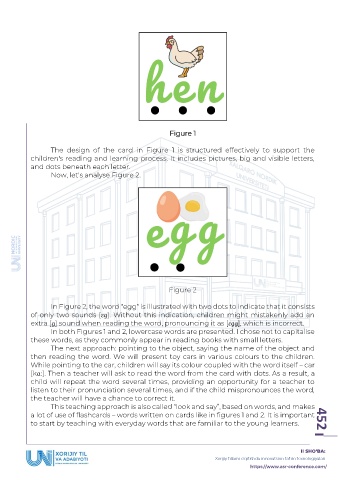Page 454 - Konferensiya to'plami - 1 (ASR)
P. 454
Figure 1
The design of the card in Figure 1 is structured effectively to support the
children's reading and learning process. It includes pictures, big and visible letters,
and dots beneath each letter.
Now, let's analyse Figure 2.
Figure 2
In Figure 2, the word "egg" is illustrated with two dots to indicate that it consists
of only two sounds [ɛɡ]. Without this indication, children might mistakenly add an
extra [ɡ] sound when reading the word, pronouncing it as [ɛɡɡ], which is incorrect.
In both Figures 1 and 2, lowercase words are presented. I chose not to capitalise
these words, as they commonly appear in reading books with small letters.
The next approach: pointing to the object, saying the name of the object and
then reading the word. We will present toy cars in various colours to the children.
While pointing to the car, children will say its colour coupled with the word itself – car
[kɑː]. Then a teacher will ask to read the word from the card with dots. As a result, a
child will repeat the word several times, providing an opportunity for a teacher to
listen to their pronunciation several times, and if the child mispronounces the word,
the teacher will have a chance to correct it.
This teaching approach is also called “look and say”, based on words, and makes
a lot of use of flashcards – words written on cards like in figures 1 and 2. It is important
to start by teaching with everyday words that are familiar to the young learners. 452
II SHO‘BA:
Xorijiy tillarni o‘qitishda innovatsion taʼlim texnologiyalari
https://www.asr-conference.com/

